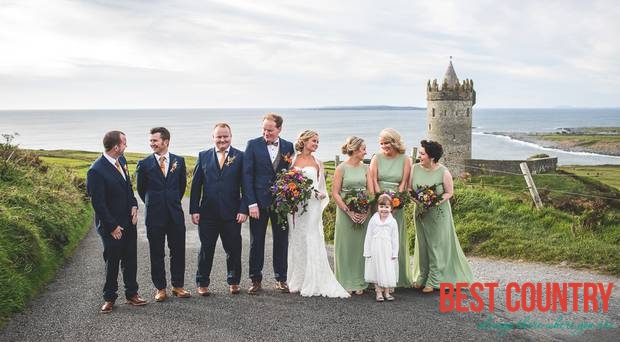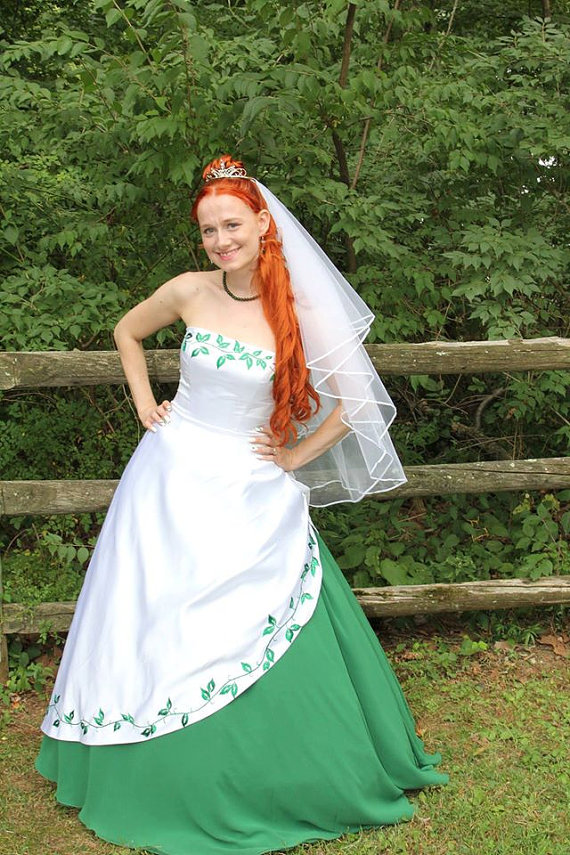An Irish traditional wedding is a beautiful ceremony to see or take part in. From the stunning attire of both the bride and groom.
Irish Wedding Traditions & Customs
 The bride would as is done to-day be dressed in a white dress to symbolize her purity. But, Irish weddings although are a lot of fun have a lot of superstitions that have to be observed and carried out lest the couple suffer the consequences.
The bride would as is done to-day be dressed in a white dress to symbolize her purity. But, Irish weddings although are a lot of fun have a lot of superstitions that have to be observed and carried out lest the couple suffer the consequences.
Before Christianity found Ireland, couples who wished to show commitment to each other practised what was known as hand fasting. This ritual was most probably carried over from Pagan times and is the Celtic ceremony of unity.
It was usual for couples to celebrate this ceremony around the estivharvest fal, Lughnasa, which occurs on 1st August.
They could choose the length of the union either “‘till death do us part” or to be together in the afterlife or even while their love burned strong and true in which case if they still wished to remain married they would renew these vows the following year.
During the ritual the couple hold hands, right hand in right hand, and left hand in left with their wrists crossed.
Ribbon or cord is then wrapped around the wrists in a figure eight to represent infinity. This is most probably where the saying “‘tying the knot” originated from.
Since the birth of Christianity weddings were held in the home of a Priest or in a Church.
Two candles burn separately during the ceremony which are then used to light one taller candle known as the Unity candle this is to signify two becoming one.
Before the Bride makes it this far proceedings will start with the proposal: ‘Would you like to be buried with my people?’ ‘Would you like to hang your washing next to mine?’
Not very romantic but every Irish girl would know what was being asked. Friends and family when enquiring about the ‘big’ day would ask: ‘When are you giving us a day out?’ or ‘Should I buy a hat?’
Next comes the all important planning, usually the poor groom ducks and takes cover and leaves all this to the bride and her family as traditionally it is the bride’s father who foots the bill.
Although now a lot of the expense is shared. Gone are the days when a marriage depended on the size of the bride’s dowry. Marriages were once based on what the bride could bring to the marriage either cattle or a farm or plot of land.
It wasn’t always based on love. It was once known for family to marry family as it was law that only a male heir could inherit and this made sure that land and property stayed within the family name.
The Irish Brides Dress
 With the Church booked and the date chosen. The bride’s attention turns to her dress and accessories. This has to chosen carefully as the color of her dress might determine how successful the marriage is:
With the Church booked and the date chosen. The bride’s attention turns to her dress and accessories. This has to chosen carefully as the color of her dress might determine how successful the marriage is:
Marry in white everything’s right
Marry in blue lover be true
Marry in pink spirit’s will sink
Marry in gray live far away
Marry in brown live out of town
Marry in green ashamed to be seen
Marry in yellow ashamed of your fellow
Marry in black wish you were back
Marry in red wish you were dead
Marry in tan he’ll be a loved man
Marry in pearl you’ll live in a whirl
This then is followed by the traditional things that she will need to have with her:
Something old, something new
Something borrowed, something blue
And an old Irish penny in her shoe.
The old Irish penny part seems to have disappeared in modern times, although no bride would dare walk down the aisle without the rest.
The something blue tends to be a blue garter worn around the top of the leg, which the groom usually has to remove using only his teeth much to the amusement of friends and family.
Irish Wedding Veil or head-dress
That’s the next choice facing the bride. Traditionally Irish bride’s would have favored a garland of wild flowers typically Lavender to be worn in their hair.
Whichever the bride’s choice she must never put her own veil or head-dress on as this is considered very unlucky.
The Weddings Rings
Traditionally the wedding band could be a Claddagh ring. This ring is of two hands holding a crowned heart.
It is very important to wear a Claddagh ring properly if you are engaged or married the tips of the crown should be facing out whereas if you are not romantically involved the tips should face the wrist indicating that you are approachable.
Claddagh rings were usually handed down through generations of mother’s to their daughter’s as it is improper to buy your own Claddagh ring although that is a tradition that is not really practiced any-more.
The Claddagh rings were made of gold although now a day’s they have become more intricate with the heart being made of a precious gem such as Emerald to represent the Emerald Isle.
The big day arrives and the first thing a bride to be will do is look out the window not to see if she will get wet if it is raining but to make sure the sun is shinning as the sun blesses the union and brings good luck.
While she is looking at the weather she will be listening hard for the sound of the cuckoo and looking to see if she can spot three magpies all a must to ensure that the marriage will be a happy one.
The ceremony over the bride and groom leave the Church traditionally to the sound of pipes. In days gone by a family member or a friend of the family who could play the bagpipes would play as the happy couple left the Church and also at the reception afterwards which would have once been held in the bride’s parent’s house.
To-day, couple’s usually hold their reception in a hotel or hires a hall depending on what the budget will stretch to.
However, the bride must travel a different way than she traveled to the church as this symbolizes the fresh start to her new life.
Blessings & toasts for an Irish Wedding
As the guests congratulate the happy couple the first person to offer their congratulations to the bride must be a man.
It’s very unlucky for a woman to do this so traditionally a male member of the groom’s family will be the first to congratulate the bride and welcome her to the family.
The merriment begins. Everybody is given a drink from mead in days of old to Champagne or sparkling wine to-day to raise and toast the health of the bride and groom.
There are many different toasts and sayings recited at weddings for example:
May there always be work for your hands to do
May your purse always hold a coin or two
May the sun always shine on your window pane
May a rainbow be certain to follow each rain
May the hand of a friend always be near you
May God fill your heart with gladness to cheer you
Other examples include:
May he bless your home
With the peace
That surpasses understanding
May your troubles be less
And your blessings be more
And nothing but happiness
Come in your door
Long live the Irish
Long live their cheer
Long live our friendship
Year after year
And not forgetting the traditional toast for any occasion: Slainte ! (pronounced SLAWN – cha)
Toasts and blessings speeches eventually over. The Irish are renowned talkers (must be because we all kissed the Blarney Stone at birth) and this part can usually last for quite a while, but eventually the dancing starts.
Thankfully these days the bride can relax now but it used to be if she could ‘carry a tune’ (sing) she would be expected to provide the entertainment as well.
This is where the groom takes his bride to the centre of the room to show the world his wife and lead her in their first dance as a married couple. Even this has to be done carefully because the new bride cannot lift both her feet off the ground at the same time or else the faerie’s may carry her away.
Cutting the cake is a very important part of the day. The guest’s all gather round to watch and cheer as the first slice is cut.
A traditional Irish cake would have at least two tiers the first would be a rich fruit cake and the smaller next tier would be soaked in good Irish whiskey and stored away to be used as a christening cake for the first-born.
Every guest is given a slice of cake to eat or in some cases taken away by unmarried maidens to place under their pillow that night in the hope that they dream of their future husband.
Celebrations over the couple are ready to leave their guests (who will usually carry on celebrating into the ‘wee small hours’) to go on honeymoon.
This word actually has nothing to do with going away but was actually honey wine (mead) that was given to the couple who would then drink it every night out of a special goblet to promote virility and also to protect the couple from the faeries who would have loved to have spirited the bride away.
Buying the perfect Irish Wedding Gift
Irish wedding gift’s that are traditionally given include items like salt and pepper shakers and tall toasting glasses (flutes) which are considered lucky gifts to receive or a porcelain bell which is given to remind the couple of the bells that rang when they married.
Irish linen or a piece of Irish lace were and still are considered a wonderful gift to receive as they represent solid commitment.
To-day no bride starts her married life without at least one piece of either the highly collectable Belleek Pottery or stunning Waterford Crystal.